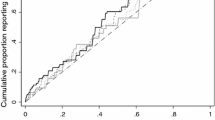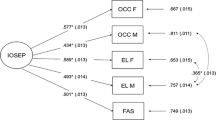Abstract
The aim of the present paper was to study the relationship between different indicators of socioeconomic position (SEP) and various health domains in young adolescents’ lives. Data stem from two studies carried out in Norway in 2004; a sample of 1,153 5th–7th graders (study 1) and a sample of 654 6th graders (study 2). Indicators of SEP were family affluence, books in home and perceived wealth. Measures of health were health complaints, overall health, and life satisfaction (study 1), measures of psychosocial resources were social competence and self-esteem (study 1), and measures of health behaviours were consumption of fruits and vegetables and physical activity (study 2). Results from study 1 showed that all three SEP-indicators were significantly associated with overall health, life- satisfaction and social competence, with perceived wealth showing the strongest relationship. Health complaints and self-esteem were only associated with perceived wealth. Results from study 2 showed that only books in home was significantly associated with all three health behaviours, while the two other indicators were not. Adolescents with higher SEP report better health, more psychosocial resources and higher level of health behaviour than adolescents with lower SEP. The results indicate that the SEP indicators differ regarding their relevance to the various outcomes. Several aspects of SEP should be included in future research and indicators suitable for adolescents needs to be further developed.
Similar content being viewed by others
References
Abel, T. (2007). Cultural capital in health promotion. In D. V. McQueen & I. Kickbusch (Eds.), Health and modernity the role of theory in health promotion (pp. XI, 170 s.). New York: Springer-Verlag.
Adler, N. E. (2007). Health disparities: What’s optimism got to do with it? Journal of Adolescent Health, 40(2), 106–107.
Adler, N. E., Boyce, T., Chesney, M. A., Cohen, S., Folkman, S., Kahn, R. L., et al. (1994). Socioeconomic-status and health—the challenge of the gradient. American Psychologist, 49(1), 15–24.
Adler, N. E., Epel, E. S., Castellazzo, G., & Ickovics, J. R. (2000). Relationship of subjective and objective social status with psychological and physiological functioning: Preliminary data in healthy white women. Health Psychology, 19(6), 586–592.
Arntzen, A. (2002). Operationalisation of class. Theoretical and empirical considerations. Nordic Journal of Epimediology, 12(1), 11–17.
Broberg, A. G., Ekeroth, K., Gustafsson, P. A., Hansson, K., Hagglof, B., Ivarsson, T., et al. (2001). Self-reported competencies and problems among Swedish adolescents: a normative study of the YSR. European Child & Adolescent Psychiatry, 10(3), 186–193.
Carroll, D., Bennett, P., & Smith, G. D. (1996). Some observations on health and socio-economic status. Journal of Health Psychology, 1, 23–39.
Chen, E., Martin, A. D., & Matthews, K. A. (2006). Socioeconomic status and health: Do gradients differ within childhood and adolescence? Social Science & Medicine, 62(9), 2161–2170.
Chen, E., Matthews, K. A., & Boyce, W. T. (2002). Socioeconomic differences in children’s health: How and why do these relationships change with age? Psychological Bulletin, 128(2), 295–329.
Currie, C. E., Elton, R. A., Todd, J., & Platt, S. (1997). Indicators of socioeconomic status for adolescents: the WHO health behaviour in school-aged children survey. Health Education Research, 12(3), 385–397.
Currie, C. E., Samdal, O., Boyce, W., & Smith, B. (Eds.). (2001). Health behaviour in school aged children: a world health organization cross-national study. Research protocol for the 2001/2002 Survey. Edinburgh: University of Edinburgh.
Elias, M. J. (1997). The Missing Piece. Retrieved December 17, 1997, from http://www.edweek.com/ew/1997/1elias.h17.
Elstad, J. I. (1998). The psycho-social perspective on social inequalities in health. Sociology of Health and Illness, 20(5), 598–618.
Elstad, J. I. (2000). Social inequalities in health and their explanations. NOVA, Oslo.
Finkelstein, D. M., Kubzansky, L. D., Capitman, J., & Goodman, E. (2007). Socioeconomic differences in adolescent stress: The role of psychological resources. Journal of Adolescent Health, 40(2), 127–134.
Friestad, C., & Klepp, K. I. (2006). Socioeconomic status and health behaviour patterns through adolescence: Results from a prospective cohort study in Norway. European Journal of Public Health, 16(1), 41–47.
Galobardes, B., Shaw, M., Lawlor, D. A., Lynch, J. W., & Smith, G. D. (2006). Indicators of socioeconomic position (part 1). Journal of Epidemiology and Community Health, 60(1), 7–12.
Goodman, E., Adler, N. E., Kawachi, I., Frazier, A. L., Huang, B., & Colditz, G. A. (2001). Adolescents’ perceptions of social status: Development and evaluation of a new indicator. Pediatrics, 108(2), e31.
Greenberg, M. T., Weissberg, R. P., O’Brien, M. U., Zins, J. E., Fredericks, L., Resnik, H., et al. (2003). School-based prevention: promoting positive social development through social and emotional learning. American Psychologist, 58(6/7), 466–474.
Gresham, F. M., & Elliott, S. N. (1990). Social skills rating system. Manual, Circle Pines, American Guidance service.
Hanson, M. D., & Chen, E. (2007). Socioeconomic status and health behaviors in adolescence: A review of the literature. Journal of Behavioral Medicine, 30(3), 263–285.
Hetland, J., Torsheim, T., & Aaro, L. E. (2002). Subjective health complaints in adolescence: dimensional structure and variation across gender and age. Scandinavian Journal of Public Health, 30(3), 223–230.
Holsen, I., Smith, B. H., & Frey, K. S. (2008). Outcomes of the social competence program Second Step in Norwegian elementary schools. School Psychology International, 29(1), 71–88.
Huebner, E. S. (1991). Initial development of the students life satisfaction scale. School Psychology International, 12, 231–240.
Hvistendahl, R., & Roe, A. (2004). The Literacy Achievement of Norwegian Minority Students. Scandinavian Journal of Educational Research, 48(3), 307–324.
Iversen, A. C. (2005). Social differences in health behaviour: the motivational role of perceived control and coping. Doctoral thesis, University of Bergen, Bergen. Available from BORA http://hdl.handle.net/1956/751.
Koivusilta, L. K., Rimpelä, A. H., & Kautiainen, S. M. (2006). Health inequality in adolescence. Does stratification occur by familial social background, family affluence, or personal social position? BMC Public Health, 6, 110.
Liberatos, P., Link, B. G., & Kelsey, J. L. (1988). The Measurement of Social-Class in Epidemiology. Epidemiologic Reviews, 10, 87–121.
Lien, N., Friestad, C., & Klepp, K. I. (2001). Adolescents’ proxy reports of parents’ socioeconomic status: How valid are they? Journal of Epidemiology and Community Health, 55(10), 731–737.
Lien, N., Jacobs, D. R., & Klepp, K. I. (2002). Exploring predictors of eating behaviour among adolescents by gender and socio-economic status. Public Health Nutrition, 5(5), 671–681.
Lien, N., Lytle, L. A., & Klepp, K. I. (2001). Stability in consumption of fruit, vegetables, and sugary foods in a cohort from age 14 to age 21. Preventive Medicine, 33(3), 217–226.
Lynch, J. W., Kaplan, G. A., & Salonen, J. T. (1997). Why do poor people behave poorly? Variation in adult health behaviours and psychosocial characteristics by stages of the socioeconomic lifecourse. Social Science and Medicine, 44(6), 809–819.
Mackenbach, J. P., Kunst, A. E., Cavelaars, A. E. J. M., Groenhof, F., Geurts, J. J. M., Andersen, O., et al. (1997). Socioeconomic inequalities in morbidity and mortality in western Europe. LANCET, 349, 1655–1659.
Marmot, M., Ryff, C. D., Bumpass, L. L., Shipley, M., & Marks, N. F. (1997). Social inequalities in health: Next questions and converging evidence. Social Science and Medicine, 44(6), 901–910.
Operario, D., Adler, N. E., & Williams, D. R. (2004). Subjective social status: Reliability and predictive utility for global health. Psychology & Health, 19(2), 237–246.
Pallant, J. (2004). SPSS survival manual a step by step guide to data analysing using SPSS for Windows (Version 12). Maidenhead: Open University Press.
Pedersen, W. (1996). Working-class boys at the margins: Ethnic prejudice, cultural capital, and gender. Acta Sociologica, 39(3), 257–279.
Quilty, L. C., Oakman, J. M., & Risko, E. (2006). Correlates of the Rosenberg self-esteem scale method effects. Structural Equation Modeling—a Multidisciplinary Journal, 13(1), 99–117.
Singh-Manoux, A., & Marmot, M. (2005). Role of socialization in explaining social inequalities in health. Social Science & Medicine, 60(9), 2129–2133.
Smith, G. D., Blane, D., & Bartley, M. (1994). Explanations for socio-economic differentials in mortality. European Journal of Public Health, 4, 131–144.
Strand, B. H., & Kunst, A. (2007). Childhood socioeconomic position and cause-specific mortality in early adulthood. American Journal of Epidemiology, 165(1), 85–93.
Taylor, S. E., & Seeman, T. E. (Eds.). (1999). Psychosocial resources and the SES-health relationship (Vol. 896). New York: New York Academy of Sciences.
Torsheim, T., Leversen, I., & Samdal, O. (2007). Sosial ulikhet i ungdoms helse: Er helseatferd viktig? [Adolescent health inequality: are behavioural factors important? Norweigian Journal for Epidemiology, 17(1), 79–86.
van de Mheen, H., Stronks, K., Looman, C. W. N., & Mackenbach, J. P. (1998). Does childhood socioeconomic status influence adult health through behavioural factors? International Journal of Epidemiology, 27(3), 431–437.
Vereecken, C. A., Keukelier, E., & Maes, L. (2004). Influence of mother’s educational level on food parenting practices and food habits of young children. Appetite, 43(1), 93–103.
von Rueden, U., Gosch, A., Rajmil, L., Bisegger, C., & Ravens-Sieberer, U. (2006). Socioeconomic determinants of health related quality of life in childhood and adolescence: results from a European study. Journal of Epidemiology and Community Health, 60(2), 130–135.
Wardle, J., Robb, K., & Johnson, F. (2002). Assessing socioeconomic status in adolescents: the validity of a home affluence scale. Journal of Epidemiology and Community Health, 56(8), 595–599.
Yang, Y. (2003). Dimensions of socio-economic status and their relationship to mathematics and science achievement at individual and collective levels. Scandinavian Journal for Educational Research, 47(1), 21–41.
Acknowledgment
The study was supported by a grant from Research Council of Norway to Ingrid Holsen. Data collection in the “Eat more!”-Study was financed by The Norwegian Cancer Association.
Author information
Authors and Affiliations
Corresponding author
Rights and permissions
About this article
Cite this article
Iversen, A.C., Holsen, I. Inequality in Health, Psychosocial Resources and Health Behavior in Early Adolescence: The Influence of Different Indicators of Socioeconomic Position. Child Ind Res 1, 291–302 (2008). https://doi.org/10.1007/s12187-008-9015-5
Received:
Accepted:
Published:
Issue Date:
DOI: https://doi.org/10.1007/s12187-008-9015-5




